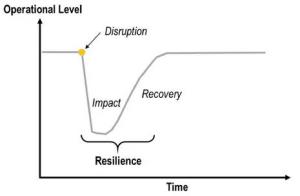Transportation Resiliency
Transportation resiliency is the ability of a transportation system to move people, goods, and services despite one or more significant obstacles to normal function. Often, communities and municipalities find themselves in a reactive position when faced with extreme weather events, significant accidents, equipment or infrastructure failures, resource disruption, and construction projects. As these disruptions become more commonplace, particularly extreme weather events, our mission as both engineers and stakeholders in the community has had to evolve to include proactive elements of design to ensure our projects and the communities they serve, are protected from such disruptions. Having a plan in place to mitigate the impact of disruptions results in lower costs incurred by communities resulting from impacts to infrastructure and allows users to resume their day-to-day functions. These types of plans are referred to as Resilience Improvement Plans (RIP).

One opportunity for regional and local municipalities/communities to develop and fund a RIP is through the USDOT’s PROTECT Grant Program. Under the Bipartisan Infrastructure Law (BIL), the Promoting Resilient Operations for Transformative, Efficient, and Cost-saving Transportation (PROTECT) Grant program provides funding to ensure surface transportation resilience to natural hazards, including climate change, sea level rise, flooding, extreme weather events, and other natural disasters through support of planning activities, resilience improvements, community resilience and evacuation routes, and at-risk coastal infrastructure. The PROTECT discretionary program offers two types of awards: planning grants and Competitive Resilience Improvement Grants. The PROTECT program provides $1.4 billion in funding over five years. Federal cost-sharing will be higher if the eligible entity develops a resilience improvement plan, or is in a state or area served by an MPO (Association of Metropolitan Planning Organizations) that does, and the state or MPO incorporates it into its long-range transportation plan.
Resilience Improvement Plans resulting from the PROTECT program will prioritize regional transportation assets through the MPO’s regional vulnerability assessment. Local mitigation plans consistent with the RIP allow local roads/assets within rural, small-town communities to procure funding.
The benefits of a coordinated regional planning approach assist decision-makers in defining vulnerability problems, achieving long-term resilience, and addressing multiple concerns with individual strategies. With rising interest among MPO and partner agencies across the state in resiliency issues and the potential for increased funding for resiliency projects through the PROTECT program, B&L can assist our clients by providing them with a model they can follow when developing their own resilience improvement plans.
For more information on Transportation Resiliency, contact B&L’s Alex Kerr or Jayme Breschard.


